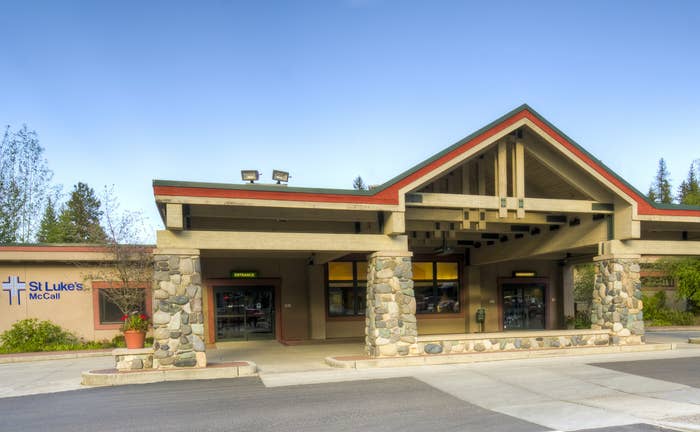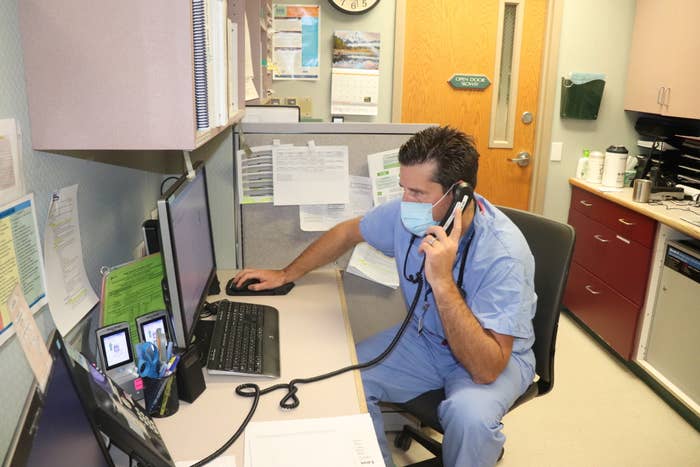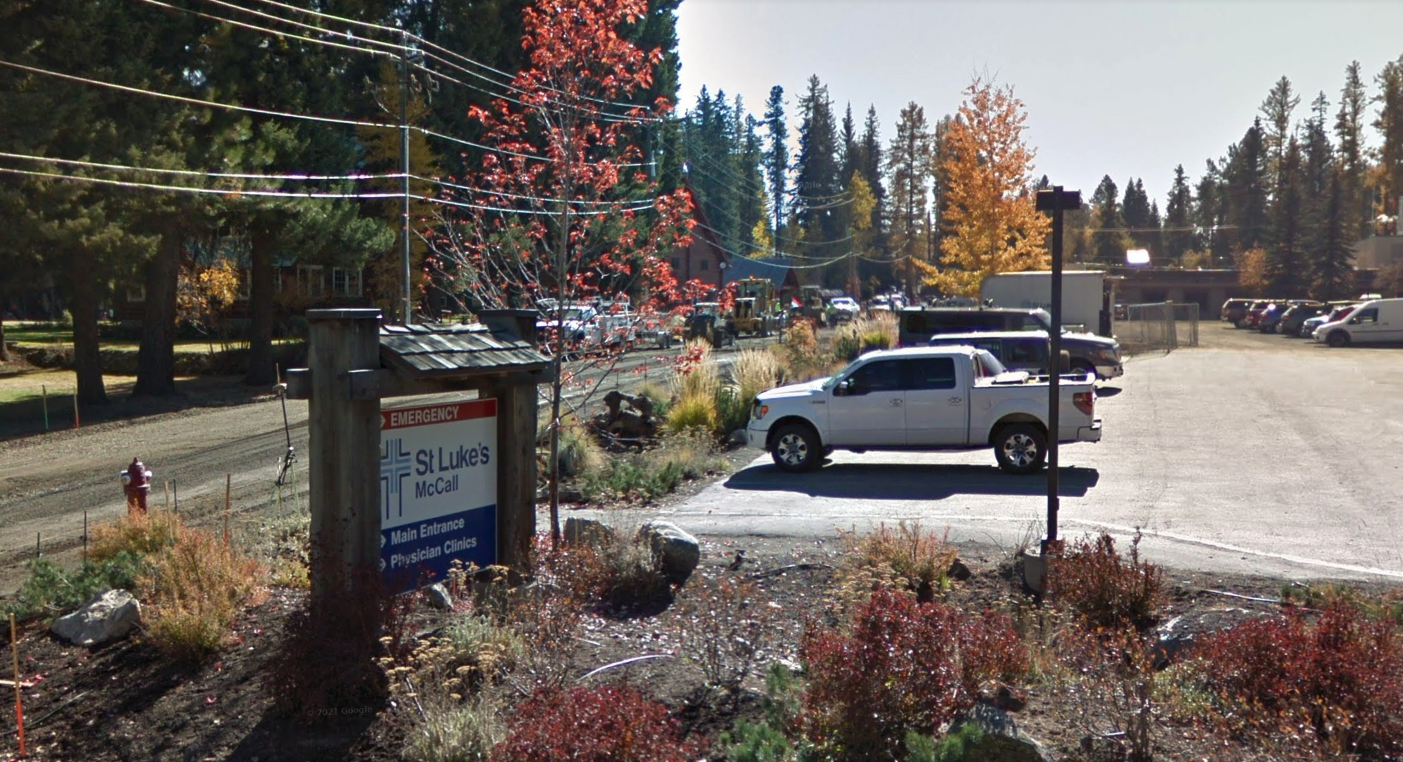
The sun was not yet up when the hospital staff walked out into the crisp mountain air and saw it.
They’d been working all night at the medical center in the Idaho resort town of McCall to try to keep a young woman alive who was extremely ill with COVID-19. They were exhausted. Reinforcements — extra nurses and a nurse anesthetist — had to be called in during the Saturday night shift to manage the woman’s airways as they waited for an ICU bed to open up at a bigger facility 100 miles away in Boise. Due to the unprecedented surge in the pandemic, right now hospitals across the state are full, and for the first time crisis standards of care have come into effect to enable medical workers to begin to ration resources. Oftentimes, beds don’t become available until patients die of the virus. Finally, though, the woman had been transported by helicopter and the medical workers could head home shortly after 4 a.m. for some sleep.
But as they walked into the parking lot, there it was: a giant swastika in orange spray paint covering the entire sign for St. Luke’s McCall Medical Center. Two smaller ones were discovered on other nearby signs. (Hospital officials have requested that photos of the swastikas not be reprinted in the media to avoid encouraging copycats.)
“It was heartbreaking,” said Paddy Kinney, a physician and the on-duty hospitalist that night. “The timing of it was tough. Anytime you leave the hospital after you’ve worked all night trying to save somebody and you go home to your family, it’s hard to leave the hospital. You’re wondering if you could have done more or if that person is going to ultimately survive the night.
“But then to leave and be faced with that on your way out the door was really heartbreaking for people.”
The discovery of the swastikas in the early morning hours of Sept. 19 has roiled McCall — a town of just a few thousand people where doctors at the 15-bed critical access hospital are more used to treating injured skiers — and made news across Idaho and the US. More than 18 months after healthcare workers were applauded nightly across the country, the graffiti in McCall has prompted soul-searching about how and why medical workers have now found themselves feeling targeted.
“It’s disheartening to hear that our healthcare workers went from feeling like heroes to feeling at risk,” Idaho Department of Health and Welfare (DHW) Director Dave Jeppesen told reporters Tuesday.
Elke Shaw-Tulloch, administrator for DHW’s public health division, said in response to a question from BuzzFeed News that state officials have offered hospitals support and resources to bolster security measures in response to alarming feedback they’ve received about medical worker safety. The Associated Press reported Wednesday that workers at one hospital in Coeur d’Alene in the state’s north are too scared to go to grocery stores unless they’ve first changed out of their scrubs.
At St. Luke’s McCall, part of the state’s biggest healthcare network, security has been increased since the swastikas were found, according to Amber Green, the facility’s chief operating and nursing officer. Another guard has been hired and police are doing more patrols. The roughly 270 employees have been warned not to go outside alone at night.
“There’s a lot of anxiety among the staff, confusion, and it’s just disheartening,” Green said. “Not just our employees feeling exhausted and depressed and anxious coming to work, knowing they have to work harder and longer than they have in the past with more acutely ill patients, but now a fear — the emotion of fear is just a whole other layer they have to deal with.”

Idaho’s medical workers are not alone in facing increased threats and violence during the pandemic. In November, National Nurses United reported that about 20% of the 15,000 nurses surveyed said they had experienced increased workplace violence amid COVID. In Branson, Missouri, hospital staff have been issued panic buttons following an increase in assaults caused in part by patients angry at extended wait times. In nearby St. Louis, a public health doctor who spoke at a council meeting to advocate for masks said he was jostled and taunted upon leaving by a crowd who called him a “fat brown cunt” and a “brown bastard.” Anthony Fauci, the most prominent and powerful US infectious disease expert, has been the subject of death threats and his daughters now have security guards trailing them. In Michigan, Adam London, the director of a county health department, said that hours after his officials had imposed a mask mandate last month, he was almost run off the road twice by a woman driving 70 miles per hour. “There is a sickness in America more far more insidious than COVID,” he wrote.
Ali Seifi, an associate professor of neurosurgery in San Antonio who has written about violence against healthcare workers for the American Journal of Managed Care, described the phenomenon as a “persistent pandemic” that has only worsened during COVID. Before last year, doctors and nurses were used to facing aggression mostly from patients using drugs or having psychological illnesses, but now it frequently comes from the family members of patients. These people are often frustrated, Seifi said, at being cut off and unable to visit loved ones in intensive care with COVID-19. “The patient’s family thinks we are hiding something from them,” he said, “and it builds up a lot of anxiety and threats within them.”
But misinformation and conspiracies have also morphed the causes of the anger being directed at healthcare workers. The American Medical Association has been forced to defend healthcare workers against “malicious, outrageous, and completely misguided” claims — from former president Donald Trump, no less — that doctors are overcounting COVID patients in order to profit. The politicization of masks and vaccines by some on the right has only made things worse.
“Now the vaccine has come out, people really don’t trust us,” said Rebecca Valverde, a nurse who works with Seifi in San Antonio. “They’re saying, ‘Oh, you’re just trying to feed into this political scheme. You don’t know what you’re talking about. The CDC doesn’t know what they’re talking about. The vaccine is poison.’ These are things that I’ve actually heard from patients and family members.”
While aghast at the prospect of a hospital being defaced with a Nazi symbol during a pandemic, Seifi said it’s unsurprising these sentiments found their way to McCall’s sign. “The only place that these people can retaliate or show their frustration is at a public healthcare setting, like a hospital wall,” he said. “This is a reality.”

Idaho has a long tradition of libertarianism that has chafed against restrictions introduced under COVID. In August 2020, protesters, led by the extremist rancher Ammon Bundy, stormed the state capitol building in Boise to interrupt a special legislative session to deal with the pandemic. In March this year, protesters held a mask-burning rally outside the statehouse.
Idaho now has the lowest vaccination rate in the country. Fewer than 40% of Idahoans are fully vaccinated, even as the highly contagious Delta variant tears through the state and continues to bring a surge of hospitalizations and deaths that has pushed the medical system to the limit.
Green, the McCall nurse, noted she and her colleagues have been very public in advocating for masks and vaccinations in their community. “We’re met on a daily basis with people that are aggressive and have a different perspective,” she said. “I feel fear and I believe my coworkers do too.”
But in their first public comments about the swastika, McCall police downplayed possible links between the graffiti and the pandemic. “There is currently no evidence indicating the hospital or staff were targeted due to COVID policies since they do not issue mandates or govern,” officers said in a statement.
Reached Tuesday, city spokesperson Erin Greaves declined to comment on the “ongoing investigation” to BuzzFeed News, but acknowledged there was a “faction of the community that does believe it was COVID-related.”
“As of right now,” she said, “the chief of police does not see a correlation between a swastika and the COVID pandemic.”
Such comments appear wildly misinformed. Allusions to Nazis have been made frequently during the pandemic around the world, in the US, and in Idaho, prompting denouncement from Holocaust memorial groups. An Idaho Republican lawmaker was condemned last year for comparing stay-at-home orders to Nazi Germany and calling the state’s governor “Little Hitler.” Another Republican lawmaker writing on Facebook complained that a business that requires shoppers to wear face masks was “too similar to not allowing Jews to shop when they were ‘required’ to wear the yellow star!!!” Bundy told protesters that if they complied with mask mandates and restrictions, officials “will go further until we are lined up naked facing a mass grave being shot in the back of the head.” Boise Public Radio last week held a discussion with a historian explaining to listeners why comparisons between the yellow stars Jews were made to wear during the Holocaust and proof of COVID vaccination were disturbing.
For days now, Kinney, the McCall physician, has wondered why someone would deface his place of work with a swastika. As far as he can tell, there are only three reasons: first, as a childish act of vandalism done by someone more interested in causing trouble than in the symbol itself, but he noted no other buildings in town were defaced; second, as a targeted message against a minority group who would feel threatened by an Aryan supremacy, such as occurred to an Anne Frank memorial in Boise last year; or third, to send a message accusing those on the other side of being Nazis.
“I think — and I think for a lot of my colleagues and the people who work in healthcare who saw this — it seems like an accusatory swastika,” Kinney said. “It seems like it’s, ‘You guys are being fascists in requiring masks and requiring vaccinations.’ That somehow in our efforts to impose rules of any kind, even common-sense rules in the most deadly pandemic of the past 100 years, that rules in general equal Nazism, which is just so silly.
“Rules do not equal fascism,” he said.

Last Friday, less than a week after the incident, several dozen people gathered at a public park by the lake in McCall to light a tree in honor of healthcare workers and to show that this act of vandalism did not represent their community. Green spoke to the crowd and thanked them for the show of support. Mayor Bob Giles said the city was committed to keeping the tree’s lights on every night until crisis standards of care are lifted in Idaho.
For Kinney, the entire affair seems to have sparked a deep philosophical reckoning about how his state and the country as a whole will contend with the competing forces of individualism and community, as well as libertarianism and the social contract we all make with one another.
“Where do we fall between those two goalposts?” he wondered. “Because this isn’t going to be the last issue we have to face like this as a country and as a community and as a people. We’ve got an entire future ahead of us of these big decisions and sacrifices and diseases and pandemics.
“Where are we going to be as a people? Where are we going to fall out?”
As he arrived at work on that morning of Sept. 19, the sun still not over the horizon, he came across the swastika with his own eyes: “A picture in the dark,” he described it. “An ominous-looking picture.”
But then he saw something else.
There, in the rain, were Green, hospital facility staff, and local volunteers working to erase the symbol and all its hatred from the hospital.
“It was a powerful image,” Kinney said. “Watching those people scrape and scrub that hateful paint off in the rain, I was proud of them. Of course, they’re not going to let that stand and be the face of our hospital for people driving by early in the morning.
“I’m proud that my team’s first thought was to get this removed and get it erased and try to continue to take care of people and save people.”
